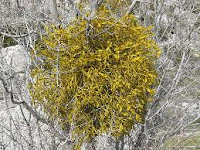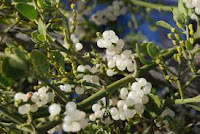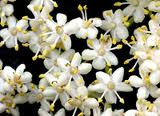 ELDERBERRIES, ELDER TREE, SAMBUCUS NIGRA
ELDERBERRIES, ELDER TREE, SAMBUCUS NIGRAThe European elder tree,
Sambucus nigra is native to the British Isles, Africa and parts of Asia, and has been naturalized in the US which also has the
Sambucus canadenisis elder, and the red-berried
Sambucus racemosus variety of elder. In fact there are quite a few different types of elder around the world, but here we concentrate on the European variety which has a long history, because of this, the
elder flowers are a separate post.
The Elder was a sacred tree to the Druids who would not take any part of the tree without first asking humbly for permission to do so. It is a tree in the Celtic calendar, and represents similar qualities to that of the astrological sign Sagittarius, the archer. The person born under this sign is a seeker, who is blunt, honest, deeply thoughtful and a philosopher, seeking truth with a passion and fire. This is the sign for late November to late December. The elder is symbolic of Transition, Evolution and Continuation. It was used as a healing herb, and the later Physicians of Myddfai used the juice from the berries to cure the bite of a viper or adder, the only venomous snake found in Britain. They believed that if bitten by a viper the juice when drunk would “disperse all poison”. In Welsh superstition if you stand under an elder tree (Ysgawen in Welsh) on Midsummer’s Eve you can see the “little people” and have visions of other worldly creatures. If you have wands from the elder, they will keep away evil spirits, witches and witchcraft, and banish negative thoughts, such as those which might lead to suicide. This may be because it was believed that Judas hanged himself on the elder tree when he was overcome with remorse for having betrayed Judas. The tree, in legend, used to grow much taller than it does today, now it grows to about 30 feet and is more of a shrub than a tree. There is an old rhyme which says: -

“Bour tree-Bour tree; crooked rong
Never straight and strong;
Ever bush and never tree
Since our Lord was nailed on thee.”
This is a reference to an old tradition that Jesus’ cross was made from an elder tree. In the 14th century it was called a bour tree. In Shakespeare’s play “Cymbeline” the elder tree is a symbol of grief and referred to as “the stinking elder” because of the smell of the bruised leaves and the flowers. Despite the smell people admire its beauty when in blossom and make wine from both the flowers and the berries. In “Love’s Labour Lost” Shakespeare writes “Judas was hanged on an Elder” and in the 14th century Langland writes in “Piers Plowman”
“Judas he japed with Jewen silver
And sithen an eller hanged hymselve”
which means that Judas played with the Jews’ silver and therefore hanged himself on an elder tree. Sir John Mandeville writing about his travels states that he was shown an elder tree identical to the one Judas hanged himself on close to the Pool of Shiloam, so the elder has strong associations with the Bible, and particularly beliefs prevalent in Mediaeval times. Flouting traditional thought of his time though, Gerard, the herbalist, states that “the tree whereon Judas did hange himselfe” was the Judas Tree, or Cercis siliqustrum.
Whatever the case even as late as the early 20
th century, hedge cutters in rural Britain would not cut the elder and gypsies are forbidden to use its wood as firewood. That may be wise, as the branches spit bits of flaming bark as it burns.
Folkard, in “Plant-Lore, Legends and Lyrics,” tells us:
'The pith of the branches when cut in round, flat shapes, is dipped in oil, lighted, and then put to float in a glass of water; its light on Christmas Eve is thought to reveal to the owner all the witches and sorcerers in the neighbourhood';
and he continues,
'On Bertha Night (6th January), the devil goes about with special virulence. As a safeguard, persons are recommended to make a magic circle, in the centre of which they should stand, with Elderberries gathered on St. John's night. By doing this, the mystic
Fern-seed may be obtained, which possesses the strength of thirty or forty men.'
The twigs are flexible and the pith inside them can be removed and superstitious country people tie three or four knots in them to protect themselves from bad luck and evil influences. Little boys use the hollowed stems as whistles and in Culpeper’s day they were used as pop-guns. In ancient Greece and Rome they were made into wind instruments, pan-pipes and flutes, for example. The music from these could, it was believed, get rid of evil spirits and protect from witchcraft, just as the leaves gathered on the last day of April and fixed to doors and windows could. Farmers used to make a cross from the twigs of the elder and place them in stables and cow byres to protect their animals.

The leaves and juice from them can be used to repel insects, and the bruised leaves can be rubbed on the skin to protect from insect bites. In the 17
th century it was believed that if other crops were whipped with bunches of elder laves no blight would attack them. If you take a handful of fresh bruised leaves and pour a pint of boiling water on them and leave this to cool, you can strain then bottle it and use on the skin as an insect repellent.
In the late 17th and 18th century, elderberry juice was used to adulterate port, until this practice was outlawed in Portugal in 1747. They believed that drinking the juice with port was cure for the pain of sciatica and neuralgia.
Hippocrates recommended the bark for a purgative, and it is an emetic. You can make this with 1 ounce of dried bark (dried in the sun and taken in at night until it turns a grey colour) to 1 pint of water and boil it, then take small doses of it. It was also used as a diuretic. A tisane of dried berries was given in cases of colic and diarrhoea. The leaves have been applied to swellings and gout to relieve the pain, as well as on wounds when boiled with a little linseed oil. This liquid was also used for piles. The Romans used the juice from the berries for black hair dye, and Culpeper also mentions that they can be used for this purpose. Elderberry syrup is good for coughs, colds and flu, as is hot elderberry wine with honey or sugar. Elderberries can be made into jam, preserves and conserves. To take the berries from the stalks you can use an “afro” comb, taking care no to bruise the fruit.
A tisane can be made from the fresh of dried berries by taking a fresh head of berries and boiling them in two cups of water, then leaving to stand for 10 mins, before straining, reheating and drinking with honey if desired.
Medical trials are still underway on the elderberry, but as the berries contain flavonoids they have
antioxidant properties, so may be good for prevention of heart diseases and cancer. They may, scientists say, have anti-inflammatory properties, and reduce the swellings of the mucus membranes for example the sinuses. They may also have antiviral properties as they have been effective against swine flu, or the H1N1 virus, as they were in lab tests, but they have not been tested on humans for these properties. Scientists can sat without any doubt that they boost the immune system, so a glass of hot elderberry wine every night as taken by country folk for centuries, may well ward off colds and flu and help with sore throats and mouths.
The Italian liqueur, Sambuca is made form elderberries and
anise traditionally.
Pregnant and breast-feeding women should avoid elderberries say the scientists.
The syrup recipe below is for coughs and colds and should be diluted, with water to taste.
ELDERBERRY SYRUP
Ingredients
1 pint of berries
2 pints water
1 inch piece root
ginger, peeled and sliced
Method
Boil all the ingredients together until the liquid is reduced by half.
Allow to cool and bottle.
Take a wineglass full of syrup and dilute with hot water and drink every night to ward off clods and flu. If you have a cold then take this dose three times a day until the symptoms have gone.
This has Taste and is a Treat(ment).

















































